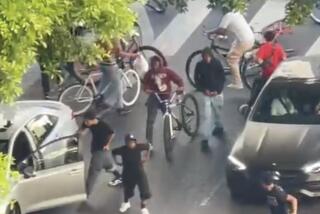Slasher of Children Has Hanoi Panicked
HANOI — For the past two weeks, a mysterious young man has sped through this capital’s streets, cutting the faces and hands of children passing on motor scooters driven by their parents.
Though none of the 14 attacks, apparently carried out with a razor, has resulted in serious injury, Hanoi has been thrown into panic. Not for years has a single subject so dominated conversation and Page 1 media attention--and not since the war has violence so altered the lives of so many.
“This kind of thing has never happened in Hanoi before,” a television cameraman said. “Never. It’s unimaginable. In New York, yes, this could happen. In Hanoi, no.”
Fearful of more attacks, parents are keeping children home, reducing school attendance by 25% in some cases. They are rushing out to buy helmets--gear Vietnam’s 5 million motor scooter users almost never wear--to protect youngsters’ faces; in the past week, the price of a locally made helmet has doubled to the equivalent of $5. Security guards have been posted at gates of many schools, and students who still ride to school on the back of parents’ scooters are apt to arrive wrapped in towels and dressed in thick winter jackets to ward off possible razor attacks. Some children travel the streets with baskets over their heads.
At Chu Van An school, Vice Director Dinh Viet Hung canceled after-school tutoring for 100 students. Parents, he said, wanted their children home early to avoid “face cutting.”
The entire Hanoi police force has been mobilized, and Chief Pham Chuyen has urged local people’s committees to help find the attacker--but not to employ vigilante justice if they do.
“Terror is rampant, and people don’t dare go out at night,” said a company manager who now leaves work early to pick up his son each day from school.
While street life appears unaffected, except for those with children, residents here say that not since the American Christmas bombing in 1972 has Hanoi known such fear; not since French colonial days, when some supported France and some Ho Chi Minh, have residents had to wonder whether passersby were friend or foe.
But if Hanoi’s response is as remarkable as the attacks themselves, there is reason. This metropolis of 3 million has a minuscule crime rate, especially when compared with any large American city. With few exceptions, the streets are safe at any time, night or day, even for a lone pedestrian; senseless, random violence--particularly involving children in a society that cherishes its young--is unheard of. No one ever had to look over his shoulder here.
Something else too might account for Hanoi’s stunned reaction. These razor attacks come at a time of:
* Increasing drug use, with 2,552 such arrests nationwide in the first three months of 1998.
* An upsurge in youths racing motorbikes through nighttime city streets; 23 bikes were confiscated by Hanoi police in one incident.
* A rising number of divorces, with almost 50,000 a year in Hanoi alone.
* A growing number of prostitutes--estimated at 52,000 in the nation--and a small (8,000) but growing group of HIV-positive young people.
In a country where half the population wasn’t born when the last Americans fled Saigon in 1975, many see these “social evils” as a warning that the discipline of Vietnam’s war years is breaking down. Some think that the nation’s newly liberalized economy is creating a class of wayward, undirected youth with too much money and free time. It is a notion that saddens and angers the older generation.
And rather than dismissing the attacks as the work of a sick individual--a probable American reaction--the Vietnamese press has offered myriad theories. Some reports suggest that the attacker is addled by a new drug whose users are mesmerized by blood; others say he has AIDS and is using poisoned razors to seek revenge against society. Still others say the assaults are a marketing gimmick by helmet sellers to drive up the price of their goods.
Police, thus far, have made little headway in their investigation, other than identifying the attacker as a dark-haired (which fits all Vietnamese) man, 20 to 25 years old. He drives a Vina Suzuki motor scooter. The 14 victims are 4 to 13 years old.
A large, angry crowd demanding vigilante justice surrounded the Dong Da police station when one suspect, who was later released, was taken in for questioning.
More to Read
Sign up for Essential California
The most important California stories and recommendations in your inbox every morning.
You may occasionally receive promotional content from the Los Angeles Times.










